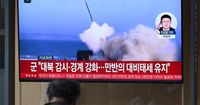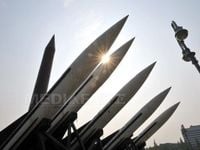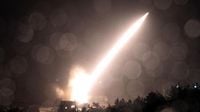North Korea launched several short-range ballistic missiles towards the Sea of Japan on Thursday, May 8, 2025, in a move that has raised alarms in the region. The missiles were fired from Wonsan at 8:10 AM local time (23:10 GMT on Wednesday, May 7, 2025) and reportedly traveled approximately 800 kilometers before crashing into the sea. This test marks the first ballistic missile activity from North Korea in almost two months, with the last launches occurring on March 10, 2025, coinciding with joint military exercises conducted by South Korea and the United States.
According to the South Korean military, this latest missile launch could be an attempt to assess the performance and flight stability of missiles intended for export. Lee Sung-jun, a spokesperson for the South Korean Joint Chiefs of Staff, stated, "It is possible that the test was aimed at verifying the performance and stability in flight of missiles intended for export." This assertion aligns with concerns that North Korea is continuing to develop its missile capabilities despite international sanctions.
The Japanese government also confirmed the detection of what appears to be a North Korean ballistic missile, which reportedly flew on an irregular trajectory. Japan's Minister of Defense, Gen Nakatani, noted that none of the missiles reached Japan's exclusive economic zone, and there were no reported impacts on Japanese vessels or aircraft in the area.
Seoul has condemned the missile launches as a clear provocation and a serious threat to peace and stability in the region. The South Korean military is maintaining close communication with the United States and Japan to share information regarding the launch and its implications.
This missile test comes amid ongoing tensions related to North Korea's military activities and its close ties with Russia. U.S. and allied intelligence agencies have accused Pyongyang of exporting ballistic missiles and other armaments to Russia for use in the ongoing conflict in Ukraine. These allegations have been denied by both North Korea and Moscow, despite evidence suggesting the transfer of military equipment.
In recent months, North Korea's military actions have escalated, with the regime under Kim Jong Un emphasizing the need to bolster its nuclear capabilities. On April 28, 2025, North Korea unveiled a new 5,000-ton destroyer, named 'Choe Hyon,' which is expected to enter service in early 2026. This new addition to the North Korean navy is part of Kim's directive to accelerate the nuclear armament of the military, aimed at defending the state and its maritime sovereignty against perceived threats.
Analysts suggest that the missile launch on May 8 could serve as a precursor to potential exports of military technology to Russia, particularly as North Korea has been increasingly involved in supporting Russian military efforts. Ahn Chan-il, a North Korean defector and director of the World Institute for North Korean Studies in Seoul, remarked that this launch may have been a test before a possible export to Russia.
The geopolitical landscape remains fraught, with North Korea's ballistic missile program prohibited under UN Security Council resolutions. The regime has, however, continued to develop and test various missile types over the years, often citing military exercises conducted by South Korea and the U.S. as provocations justifying their actions.
Relations between North Korea and South Korea are at their lowest point in years, with the North officially abandoning hopes for reunification last year. Technically, the two Koreas remain in a state of war, as the conflict that began in 1950 ended only in an armistice, not a peace treaty. This ongoing tension underscores the fragility of security in the region and the potential for further escalations.
As the international community watches closely, the ramifications of North Korea's missile tests and its military collaborations with Russia will likely continue to be a source of concern for global security.



